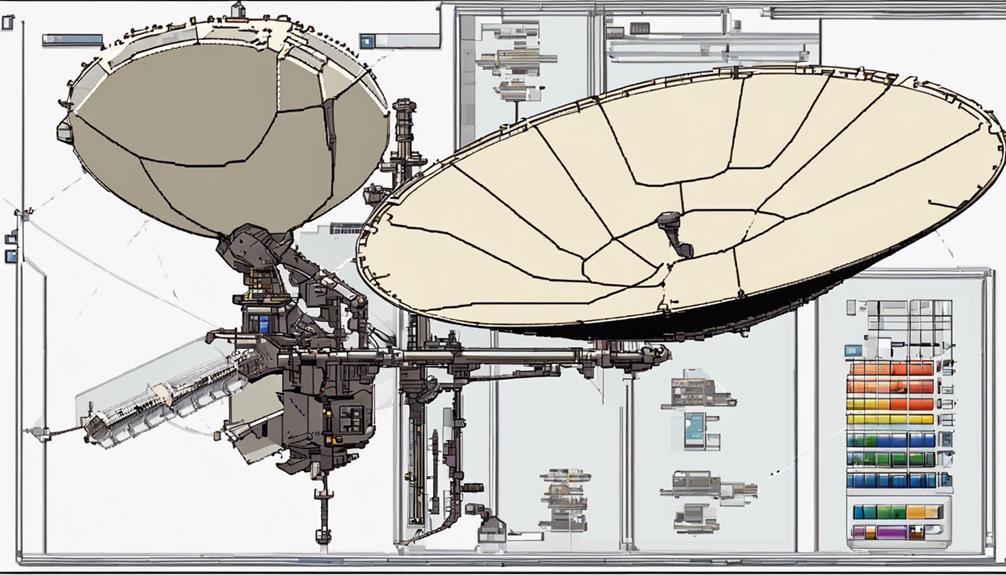Satellite antenna design intricately weaves together engineering precision and strategic functionality to optimize the transmission of signals across vast distances. The meticulous calibration of dish antennas, the focused performance of horn antennas, and the versatile capabilities of phased array antennas all contribute to the intricate web of satellite communication technologies. Understanding the nuances of these antennas is paramount in ensuring seamless connectivity and data transfer in the realm of satellite applications. As we delve into the realm of satellite antenna design and function, a deeper appreciation for the synergy between form and function emerges, shedding light on the critical role these antennas play in our interconnected world.
Key Takeaways
- Phased array technology enables precise beam steering for efficient satellite communication.
- Satellite antennas optimize signal strength and directionality for reliable Earth coverage.
- Advanced antenna designs enhance performance and reliability in satellite tasks.
- Beamforming through array antennas improves Earth Observation and communication capabilities.
Dish Antenna Design

Dish antenna design, characterized by the utilization of parabolic reflectors to concentrate incoming signals onto a feed horn at the focal point, plays a crucial role in achieving high gain and directivity for efficient long-distance communication. The distinctive parabolic shape of dish antennas enables them to focus signals onto a specific point, maximizing the received signal strength. This concentration of signals is vital, especially in satellite communication systems where clear and strong signals are imperative for effective data transmission.
The feed horn, placed at the focal point of the parabolic reflector, receives the concentrated signals and transfers them to the receiving equipment. The efficiency of this design is remarkable, with concentration ratios of up to 2000 being achievable. This high gain is essential for long-distance communication where weak signals need to be amplified for proper reception. Dish antennas are widely utilized in satellite communication due to their ability to efficiently capture and concentrate signals from distant sources.
Moreover, beyond communication applications, dish antennas find use in solar dish power plants. In these systems, the parabolic dish focuses sunlight onto a receiver, typically a heat engine, to generate electricity with high efficiency. The precision and effectiveness of dish antenna design make them indispensable in various technological applications requiring focused signal reception and transmission.
Horn Antenna Function
Horn antennas serve as essential components in radar systems and satellite communications, renowned for their pyramid-shaped design that enables precise directional transmission and reception of electromagnetic waves. These antennas are classified as directional antennas due to their ability to concentrate signals in a specific direction, offering high directivity. The pyramid shape of horn antennas contributes to their narrow radiation pattern, allowing for efficient transmission and reception of electromagnetic waves in desired directions.
Primarily utilized in microwave frequencies, horn antennas are favored for their capability to produce well-defined radiation patterns, crucial in applications requiring focused beams. Their design minimizes signal interference and enhances signal strength in communication systems, making them ideal for satellite communications and radar systems where reliable and accurate signal transmission is paramount.
In radar systems, horn antennas play a critical role in emitting and receiving radar signals with precision, aiding in target detection and tracking. Similarly, in satellite communications, horn antennas facilitate the exchange of data between ground stations and satellites by ensuring the efficient transmission and reception of signals over long distances. Overall, the functionality of horn antennas in directing electromagnetic waves makes them indispensable in various communication and radar applications.
Phased Array Antenna Characteristics

Phased array antennas employ a sophisticated beam steering mechanism achieved through the integration of multiple array elements. This design enables precise control over the direction of the antenna's radiation pattern. By adjusting the phase and amplitude of each element's signal, phased array antennas can dynamically steer beams to specific locations, a fundamental characteristic crucial for various applications in modern communication systems.
Beam Steering Mechanism
In modern satellite antenna design, the beam steering mechanism employed in phased array antennas plays a pivotal role in achieving precise control of beam direction through electronic means. Phased array antennas offer advanced capabilities for beam direction control, enabling high directivity and adaptive beamforming. Here are key points regarding beam steering mechanisms in phased array antennas:
- Electronic beam steering allows for rapid beam scanning and dynamic tracking without mechanical movement.
- Beam shaping is achieved by adjusting the phase and/or amplitude of individual elements in the array.
- Phased arrays facilitate interference suppression, enhancing the efficiency of satellite communication systems.
These features make phased array antennas a preferred choice for applications requiring agile and precise beam control.
Array Element Integration
Array element integration in phased array antennas involves the precise coordination and control of multiple elements for electronic beam steering and shaping. Each array element incorporates phase shifters and amplifiers to enable beamforming, allowing for electronic beam scanning without mechanical movement. This integration facilitates adaptive beamforming, enabling dynamic adjustments to radiation patterns for optimal performance. Additionally, phased array antennas offer rapid beam switching capabilities, crucial for applications requiring swift changes in beam direction. The coordinated efforts of these array elements result in efficient beam steering, enhancing the overall functionality of the antenna system.
| Array Elements | Phase Shifters | Beamforming | Beam Steering |
|---|---|---|---|
| Multiple components | Enable precision | Electronic beam control | Efficient direction |
Satellite Antenna Communication Roles
Satellite antennas fulfill critical communication roles by transmitting and receiving signals for satellite communication systems, ensuring efficient long-distance communication through signal focus and amplification. These antennas are integral components of satellite systems, serving the following key functions:
- Signal Transmission: Satellite antennas transmit signals from the satellite to specific regions on Earth, enabling communication over vast distances. They play a vital role in ensuring that the transmitted signals reach their intended destinations with accuracy and clarity.
- Signal Reception: In addition to transmitting signals, satellite antennas also receive incoming signals from Earth. By capturing these signals effectively, the antennas facilitate bidirectional communication between the satellite and ground stations, enabling seamless data exchange.
- Signal Amplification: Satellite antennas are designed to amplify signals, enhancing their strength and quality for improved communication reliability. This amplification process is crucial for overcoming signal degradation over long distances and ensuring that the transmitted data remains clear and intelligible.
Through their ability to transmit, receive, and amplify signals, satellite antennas play a crucial role in establishing and maintaining effective communication links between satellites and ground stations, contributing to the seamless operation of satellite communication systems.
Antenna Design for Satellite Applications

Having established the critical communication roles of satellite antennas, the focus now shifts to the intricate field of designing antennas tailored specifically for satellite applications, where optimization for specific frequencies and performance requirements is paramount. Antenna designs for satellite applications involve a meticulous process of selecting and configuring antenna elements to ensure efficient transmit and receive capabilities. In the realm of communication satellites, array antennas play a pivotal role in enhancing signal strength and controlling beam direction. Phased array technology is commonly employed to achieve beamforming, allowing for dynamic beam steering and shaping to facilitate Earth Observation and other satellite tasks.
The design of satellite antennas must also consider the harsh space environment, requiring antennas to endure extreme conditions while maintaining precise signal accuracy. Radomes, protective enclosures covering antennas, are essential components that shield antennas from weather elements and help preserve signal integrity. To achieve optimal performance in space, advanced simulation tools like SIMULIA are utilized to simulate and optimize antenna designs before deployment. By integrating cutting-edge antenna technology and leveraging array antennas with phased array capabilities, satellite communication systems can achieve heightened efficiency and reliability in transmitting and receiving signals for various satellite applications.
Understanding Satellite Antenna Technology
In the realm of satellite communication systems, a comprehensive understanding of satellite antenna technology is indispensable for ensuring efficient signal transmission and reception. Satellite antennas play a crucial role in concentrating transmitting power into specific regions on Earth to establish reliable communication links. To achieve this, reflector antennas, such as parabolic and Cassegrain antennas, are commonly utilized in satellite communications due to their high gain and efficiency. These reflector antennas employ designs like offset-parabolic structures to prevent aperture blockage and multibeam antennas for covering multiple regions simultaneously.
Moreover, the technology behind antenna reflectors extends to applications like solar dishes, which leverage parabolic reflectors with high energy conversion efficiency to generate power from sunlight. When considering the transmission of signals through the RF wave propagation in satellite communication, atmospheric conditions can impact the quality of communication links. Strategies such as incorporating increased link margin become essential to ensure reliable signal transmission despite these atmospheric interferences. Understanding the intricacies of antenna systems, reflector antennas, multibeam antennas, and RF wave propagation is paramount in designing and operating satellite communication systems efficiently and effectively.
Frequently Asked Questions
What Are the Four Main Types of Antennas Used in Satellites?
The four main types of antennas commonly used in satellites are wire antennas, horn antennas, reflector antennas, and array antennas. Reflector antennas, like parabolic reflectors, are favored for their simplicity, light weight, and high gain in communication satellites. Wire antennas serve tracking, telemetry, and command functions. Horn antennas, such as Yagi Uda designs, offer directional capabilities. Array antennas, including dipole arrays, provide steerable beams for communication purposes in satellites.
What Is the Function of Satellite Antenna?
The function of a satellite antenna primarily involves signal reception and transmission. It encompasses beam shaping to focus and direct electromagnetic waves for long-distance communication. Frequency optimization ensures specific frequencies are captured from the electromagnetic spectrum. Polarization adjustment, signal strength, and link budget are crucial for efficient data transmission. Ground station connectivity and tracking accuracy are essential for establishing reliable global satellite communication networks.
What Are the Antenna Design for Satellite Communication?
Antenna designs for satellite communication encompass parabolic reflectors, dipole antennas, helical antennas, array antennas, feeder antennas, polarization control, beam scanning, and ground station tracking. These designs are crucial for achieving optimal gain, bandwidth, directivity, and efficiency in satellite communication systems. Each type of antenna serves a specific purpose and can be tailored to meet diverse operational requirements in satellite communication networks.
What Are the 3 Basic Types of Antennas?
Antennas come in various types, with three fundamental categories being wire antennas, aperture antennas, and reflector antennas. Wire antennas, like dipole and Yagi antennas, are simple and widely used. Aperture antennas, including parabolic and helical antennas, offer directional properties. Reflector antennas, such as log periodic and patch antennas, like parabolic dishes, provide high gain and long-distance communication capabilities. Each type serves specific purposes based on their design and functionality.
